Excursion to Modrý Kameň
It was still oppressively hot and humid here in Slovakia on this particular week. Unfortunately, the day after we went swimming at Hotel Aquatermal, Simon developed mild cold symptoms (occasional light cough, bit of sneezing, slight runny nose), and not wanting him to get worse, we tried to take it easy that day. We were supposed to go to Bratislava the following day, on Friday, but we thought we'd hold off one day just to make sure Simon's symptoms didn't worsen.
We took a drive in our air-conditioned rental car mostly as an excuse to escape the godawful heat. We drove down to Modrý Kameň, which I wrote briefly about back in 2014, which is an old castle and small town about 35 minutes southwest of Podrečany (and just north of a larger, hideous, super depressing industrial town called Veľký Krtíš that was thoroughly made over by the communists). While the town of Modrý Kameň (population: 1,632; first written mention: 1290) looks a bit run down and sleepy, with a few derelict, crumbling communist-era buildings occupying very prime spots of real estate right in the center of town, the older houses in the hills that rise up steeply from the town center are appealingly ramshackle and clustered in a seemingly random patchwork along the narrow lanes that snake up the hill.
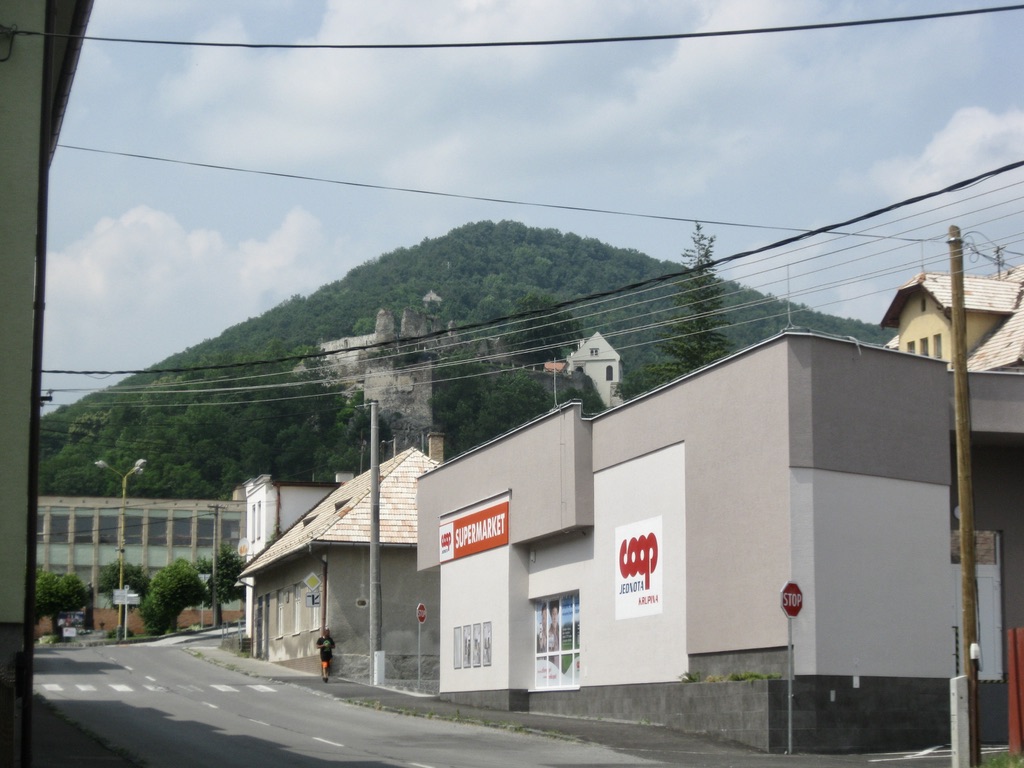 |
| No, I wasn't trying to photograph that lovely Coop grocery store front, but rather, that medieval castle ruin on the hill beyond it. |
 |
| A derelict communist-era building right smack in the center of Modrý Kameň. |
It's a quiet town that feels and looks a bit rough around the edges—to the point where at times it seems almost more sketchy than charming. The castle itself looks quite striking from the town center down below (if you can ignore the Coop supermarket and drab abandoned communist building in the foreground when looking up at it from the main street). The complex consists of ruins of the original medieval castle, and an 18th-century Baroque mansion built atop part of the ruins. Behind the castle, the steep hill continues, and there is a calvary trail that twists and turns in a switchback up the steep slope.
The 18th-century castle building contains a decent-sized museum that features antique marionettes and folk toys, as well as some other stuff. Though it was nice and relatively cool inside the thick stones walls of the building, Simon didn't want to go into the museum, and we were okay with that since it required a guided hour-long tour, so you couldn't just hop through it yourself on your own, and our six-year-old son does not have the attention span for an hour-long guided tour, in Slovak no less.
We tromped around the lower bastions behind the mansion overlooking the town (the higher one is closed while some sort of reconstruction work is being done to it), and took in the dramatic views of the town center below and the valley just beyond it. It really is an oddly striking town, and its location in a steep, narrow sort of canyon in a forest makes it a bit reminiscent of Banská Štiavnica (if you squint your eyes, it's almost like a much smaller, kind of depressing, run-down, and sleepier Banská Štiavnica).
Directly in front of the mansion, however, located down in what appears to have once been a moat, is a portal and stairway that lead down into a man-made subterranean tunnel. There was nothing particularly special about the cave-like tunnel itself (it was dug into dense layers of subterranean rock and was once used as a place to refrigerate meat and wine), but what made us love it on this sweltering day was the fact that it felt about 40 degrees (Fahrenheit) cooler down there. It was extremely difficult to leave, even though there was nothing down there except a sign that explained what it was used for and a few motion-sensor lights.
As for the history of the Modrý Kameň castle (whose name means "blue rock"), I'm finding conflicting information. The castle was originally built in the second half of the 12th century, though I see conflicting reports about who first inhabited it. Most sources say the Hungarian Balassa noble family owned it first, though another source says the original owner was someone named Ditrich of the Donč family from Zvolen. Either way, by the 1500s, it was one of many castles in the region that collectively formed a defensive line against the Ottomans.
 |
| It was so freakin' hot here! |
The castle was captured by Ottomans in 1576, and again, I'm getting conflicting reports about how that actually went down. One source says the guards stationed there simply freaked out and ran off when they heard the Ottomans approaching. Another source says that the castle was actually quite difficult to breach, and that the Ottomans bribed a local townsperson who showed them where to place their cannons on a nearby hillock, from which they were able to successfully shoot at and breach the castle walls and overtake the castle. The Ottomans destroyed the castle in 1593, but it was retaken soon after and restored in the early 1600s by Sigismund Balassa. The castle was severely damaged numerous times after that, but the Balassa family built the Baroque mansion that you see there today on top of the original castle ruins in 1730.
The setting of Modrý Kameň is quite scenic, but man, this looks like kind of a rough, backwater town whose lone tourist attraction is probably not big or exciting enough to draw that many people. I have not seen any mention of important industries there, and although it's quite close to Veľký Krtíš (a big mining and agricultural town), both towns are kind off the beaten path and out in the middle of nowhere. I suspect the castle is the one thing bringing a modicum of cash into the town and which keeps it from being even more of a backwater. Just take a look at the Hotel Hrad, below, to see how booming this place is.
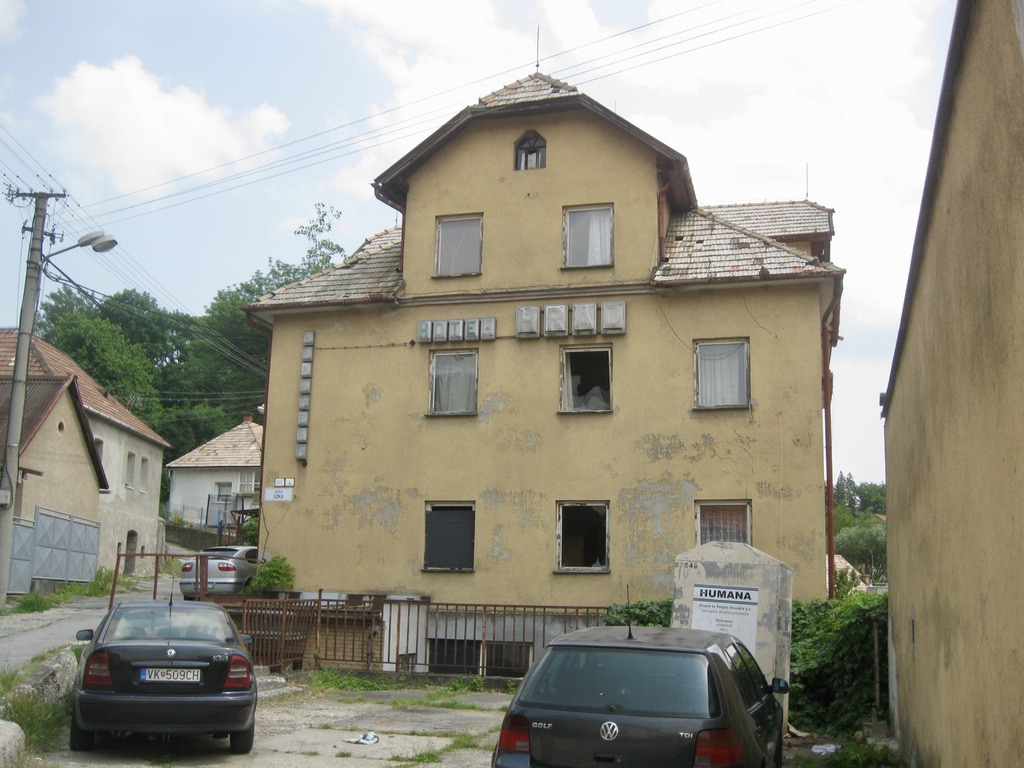 |
| Hotel Hrad appears to have fallen on hard times. |
 |
| Modrý Kameň's vibrant, cosmopolitan town center. |
Finally, a Short Trip to Bratislava
Simon was feeling much better Saturday morning, so we packed up the rental car and casually made our way back to Bratislava to stay at Terezia's cousin Ľudmila's flat. Ľudmila, as I've mentioned in earlier posts, is married to Christophe, from Germany, and they have two adorable daughters: Sasha, who is five, and Zuzana, who is two.
It felt great to get out of Podrečany, as we were starting to feel a bit stir-crazy after all that time spent in the tiny village.
We first made a quick stop at Tony's house in Bernolákovo to drop off a bag of produce straight from Terezia's mom's garden. We weren't allowed to come inside because their daughter, Tea, had come down with some horrific plague or other. We saw her looking glassy-eyed and coughing her head off in the entryway to their house.
I mentioned on our last trip that Ľudmila and Chris own a lovely, spacious, modern flat in the Dlhe diely district of Bratislava, which is at the western end of the city, situated atop a steep hill along the Danube.
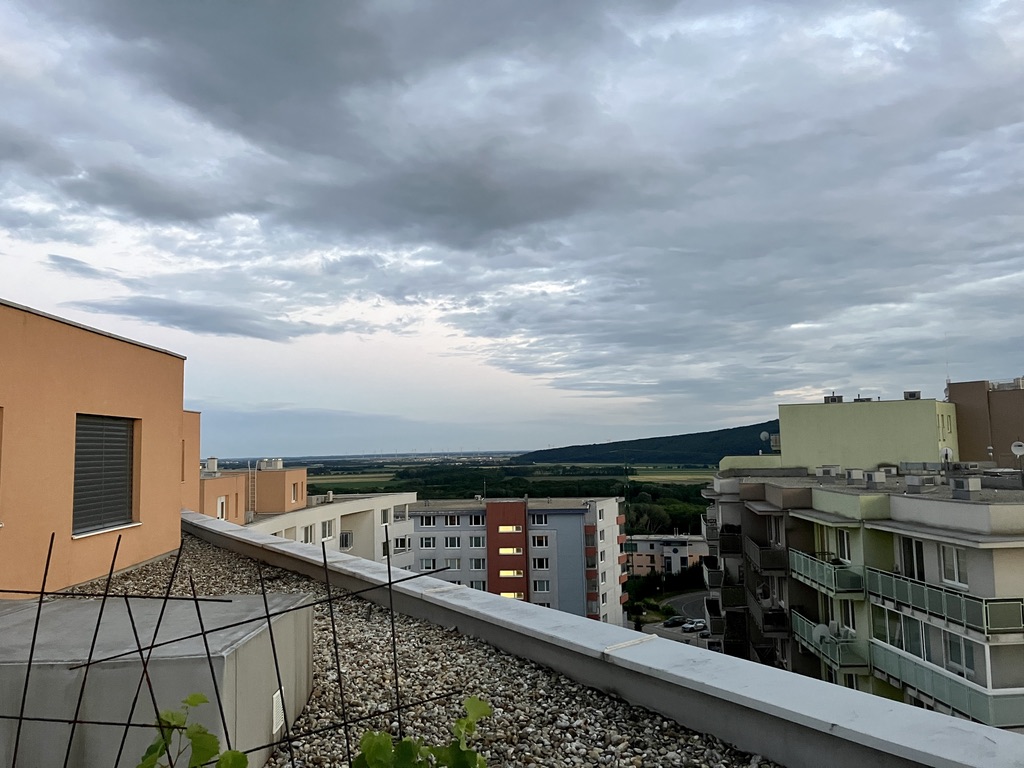 |
| The view towards Austria from Ľudmila and Chris' rooftop terrace. |
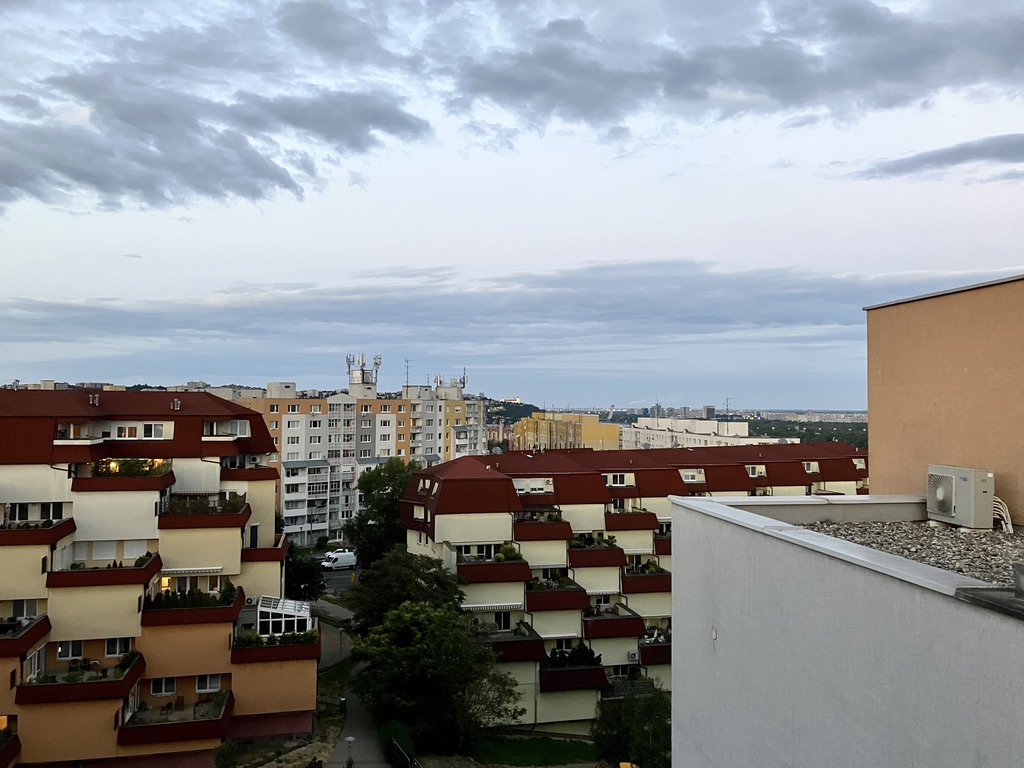 |
| The view towards Bratislava's old town from Ľudmila and Chris' rooftop terrace. If you expand the photo you can just make out the tip of the castle right in the center of the image. |
Since they have two little kids and we have a little kid, that meant whatever we did was going to be in some way kid oriented.
After settling in, we all took a bus and tram into the center of town (which Simon found very exciting; he loves riding on public transit), then walked several blocks to a place called Mint, which is a very stylish-looking and spacious restaurant (big, open windows, high ceilings, and a mix of industrial and reclaimed wood chic) situated in a very old, recently reconstructed/renovated building. It has this massive play area for kids at one end of the space. The play structure consists of this multi-level thing filled with ladders and pillows, and kids can climb all over it. At one point, Simon, Sasha, and Zuzka decided to transform one of the little rooms into their "family room." Simon stacked up all of the pillows to make it feel comfy, and then barricaded the entryway and refused to let other kids in, shouting, "You can't come in—this is our family room!" He soon relented, though, as his "family room" looked to inviting to resist.
The food (we ordered pizza) was surprisingly decent, with good crust. The wine and beer were fine, if overpriced by typical Slovak standards.
After spending a while there, we then relocated to a place in Ľudka and Chris' neighborhood in a semi-circular courtyard just steps away from their building. We ordered drinks and more pizza and sat outside on the terrace, while the kids alternated between playing on an outdoor play structure in a playground in the courtyard, and messing around with a random pile of toys in the "kids corner" of the pub we were eating at.It has apparently become common for restaurants and some pubs in Slovakia to provide spaces for kids to play in. This is a fairly new thing—you never would have seen this during communism. But now going out to eat or to the pub has become much more of family thing; it's no longer just the men going out and getting snockered while the moms are stuck at home with the kids. Establishments are really making an effort to be more family friendly, so whether it's just a messy pile of toys in a back corner of a restaurant or pub, or an elaborate jungle gym/play structure, there's a real effort to make places as kid friendly as possible. I sure don't see this much in the Bay Area (except for garbage places like MacDonald's or Chuck E. Cheese).
The next day we went to yet another restaurant that strikes a balance between appearing moderately upscale-aspirational, "hip," and family friendly, called Kubu. Again, in the large, industrial-chic space, complete with exposed air ducts and pipes, all painted black, with vintage hardbound books lining all the window sills, there was in one corner a multi-level kind of fort with chests full of random toys at the base for kids to play with.
But what I found even more impressive was Kubu has a kids pizza-making station, where kids can go to a special kid-height counter and mess around with real, fresh pizza dough, which they can knead, roll out, mold, and shape with cookie cutters and other implements, and there was even a guy behind the counter who would take your kids' dough shapes and bake 'em in the oven for them! I honestly thought this was genius. Simon, Sasha, and Zuzka each came out with a bag full of pieces of baked pizza crust cut into stars, hearts, and other shapes. And it was good crust! We were snacking on it later that day.
 |
| Simon, Sasha, and Zuzka at the pizza-making station at Kubu. |
 |
| Simon's baked pizza crust shapes from Kubu. |
The food was decent: basically, it was striving to be a bit more upscale and modern with "gourmet" hamburgers, contemporary and well-presented "pub food," and a variety of Italian pasta dishes and pizzas, but not quite making it, though it was generally okay. I had a salad that was actually quite good (kind of a rarity in Slovakia), and a linguine with pesto that was a little light on the pesto.
Sadly, Terezia was not feeling well Sunday, and felt even worse Monday morning. We were supposed to go to Bernolákovo to stay at Tony's Monday night before heading back to Podrečany, but with Terezia feeling like crud, and with Tony calling to tell us that their son, Timotaj, had just come down with a nasty cough, that plan was off. However, I had plans to meet up with my friend James Monday night, so Terezia and Simon drove back to Podrečany Monday morning without me, and let me stay one extra day and night in Bratislava at Ľudka and Chris' flat, and I took the train back the next morning.
Old Town
After Terezia and Simon left Monday morning, I spent the late morning and early afternoon that day piddling around Bratislava's old town. I hadn't been able to do this at my own pace in years—not since before Simon was born. It was incredibly nice to take it all in at a leisurely pace and see what's changed and what's still the same.
One exciting discovery I made was that the tiny, old eastern orthodox church that clings to the eastern slope of the Bratislava castle hill (St. Nicholas Church), was—for the very first time that I've ever seen—open to the public. During the entire time we lived in Bratislava, this mysterious little church's door was chained and padlocked, and I've always wondered what it looks like inside. I can say now that its interior is one of the coolest I've seen in the whole country.
The interior is small and dimly lit, with dark, soot-stained walls marked by cracks, water stains, and chunks of missing plaster, and every inch of space is crammed with ornate Baroque altars and other details. Many of the old, historical churches in Slovakia, though nice inside, have been a little overzealous with their reconstructions and scrubbings. A lot of them have had their aged, worn, exposed stone walls covered in plaster and bright white paint, or even painted over with fake brick-and-mortar patterns, so it's increasingly rare in Slovakia to see old church interiors that still have centuries of grime and which ooze that special atmosphere.
 |
| The lush, green canopy under the rows of trees along the attractive Hviezdoslavovo námestie, with Cafe Verne's outdoor seating on the right. |
An Eventful Train Ride Back to Podrečany
I made it to Bratislava's barely adequate main train station the next morning, and the ride was off to a great start until the second stop, at Galanta, when a man who smelled as if he hadn't showered since the end of communism boarded the train, whose vile death stench permeated a good portion of the open car. This man's non-breathable, short-sleeved button-down polyester shirt was likely not helping matters. He sat down directly across from another man who spent three or four minutes visibly trying to just breathe through his mouth before getting up and moving to the other end of the car.
Curiously, stink man was with a woman who appeared to be his wife, who was reasonably well put together, which raises the question of why she was apparently okay with being out in public with her husband emitting a stench that made everyone in a 10-foot radius wilt.
Later on during the ride, after stink man and his wife got off, I noticed the conductor getting into a verbal altercation with a passenger at the other end of the car. I paused the music on my iPhone and could hear through my Air Pods this older male passenger with a shaved head and an annoying, raspy, slurred voice shouting in a cocky, combative tone. I noticed the conductor had pulled out a phone and was talking to someone, and as the raspy-voiced guy kept running his mouth, the conductor, fuming, snapped at him twice to shut up, shouting "Buď ticho!", which Terezia tells me is one way to tell someone to shut up in Slovak.
When the train came to the next stop in Žarnovica, the confrontation continued. Soon, two police officers came sauntering across the platform up to the train, and the unruly passenger, upon seeing them, stood up and staggered off onto the platform (perhaps wanting to avoid making even more of a scene?). As the police led him to the train station, he stumbled over the platform, appearing to be drunk. One of the police officers and the conductor then appeared to be writing and later comparing notes (a report about what transpired?) for what felt like an eternity. Eventually, the conductor got back on and the train finally started moving again. The whole incident at Žarnovica lasted about 15 minutes.
My Slovak is too poor to make out what was happening, but maybe the guy hadn't purchased a ticket? Or maybe he was a known repeat offender? He didn't appear to be causing any trouble until the conductor approached him, so maybe that was it?
Terezia and Simon were ever so kind enough to pick me up in Zvolen, which is the last stop that this train makes before Podrečany, so I didn't have to take the train all the way to Lučenec, which is a couple stops after Podrečany. (This was a regional "express" train, so it only stopped at the bigger, more important stations, and not at every little podunk town and village.)
Fiľakovo
The next day, we took a trip down to the Fiľakovo castle ruin. I've written about it here, so I won't regurgitate reams of info about it. I'll just briefly mention that it was built in the 13th century, captured by the Ottomans twice, in 1554 and 1593, and in 1682 it was destroyed and has remained in ruins ever since (with the exception of a few recent reconstructions). It was built atop a large, visually striking outcropping of rock which contains a lot of well-defined layers (i.e., the lines you see in the rocks when you cut through them), which gives the rocks these unique, wavy patterns.
Our main reason for going again was that it was something to do in the area that wasn't too far away, plus Simon is now old enough to understand and appreciate what the place is and make lasting memories of it. The last time we went, he was one-and-a-half years old and was mostly just interested in picking at some pebbles on the ground. But these days he really seems to like visiting these old castles and castle ruins.
It was a beautiful day—that nasty heat wave from the previous week had passed, and we had a perfect balance of blue sky and fluffy, white clouds.
As we were tromping around the place, a man (probably in his 40s) who was there with his family overheard us talking and asked us where we are from. He was from Hungary, and he said that while he liked the castle, the large stretches of communist-era apartment blocks that dominated some of the views of the surrounding area were less than ideal. (Not sure why this would be a surprise, though, since Hungary has plenty of its own communist-era panelaks.)

On our way out, a guy at the ticket window told us to walk around to the side that faces a narrow lane to see a newly opened tunnel that was used as an underground shelter during WWII. The long, dimly lit tunnel leads deep into the rock beneath the castle, and contains lots of posters with old photos and info about Fiľakovo during WWII, the Nazi occupation of Fiľakovo, the Soviet liberation and subsequent occupation, and a large display at the very end of the tunnel listing the names of all the Jews in the town who were killed by the Nazis, along with the ages when they died. There were also display cases here and there containing WWII-era weapons, shells, and various other artifacts.
 |
| Inside the underground WWII tunnel/shelter/bunker beneath the castle. |
 |
| A drawing of how Fiľakovo castle looked in its heyday. |
After Fiľakovo, we stopped in Lučenec to have lunch at a place called Biela Labuť. When we got there, there was all this commotion out in front, with fire trucks, firefighters, paramedics, and police on the scene. It turns out a large section of an even larger tree had fallen onto the outdoor seating area of the restaurant, just 20 minutes before we got there. Only one person was hurt (according to a waiter, a woman was hit in the head and had to be taken to the hospital), but given the size of the tree and the area where it fell, this could've been far, far worse.
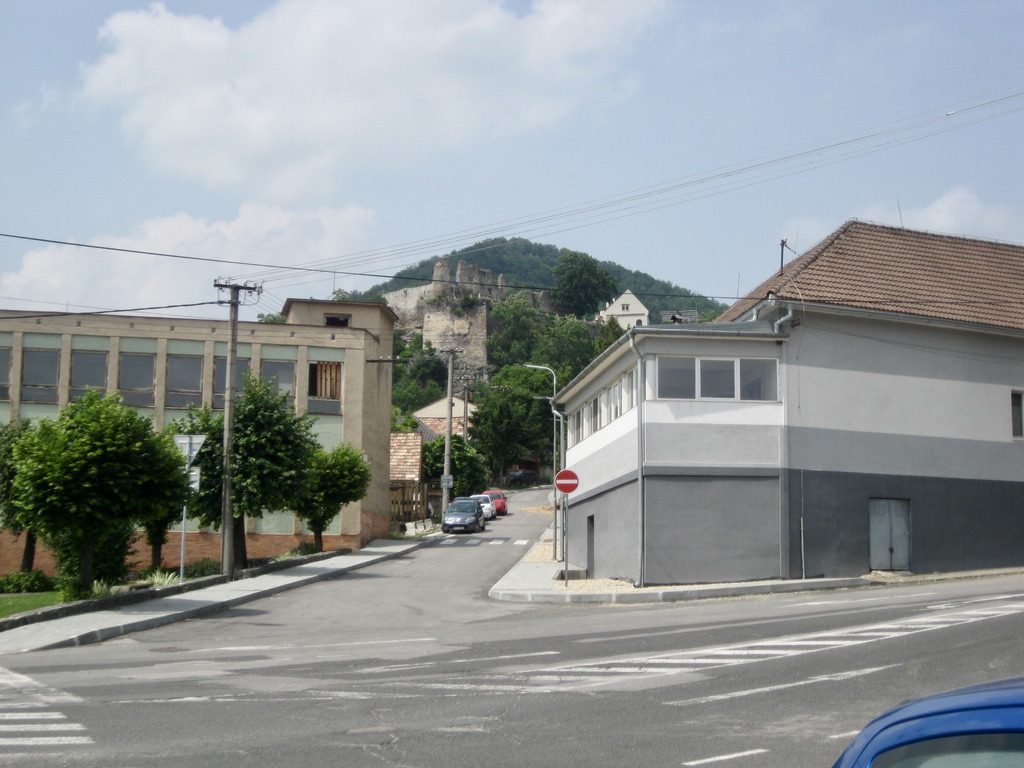


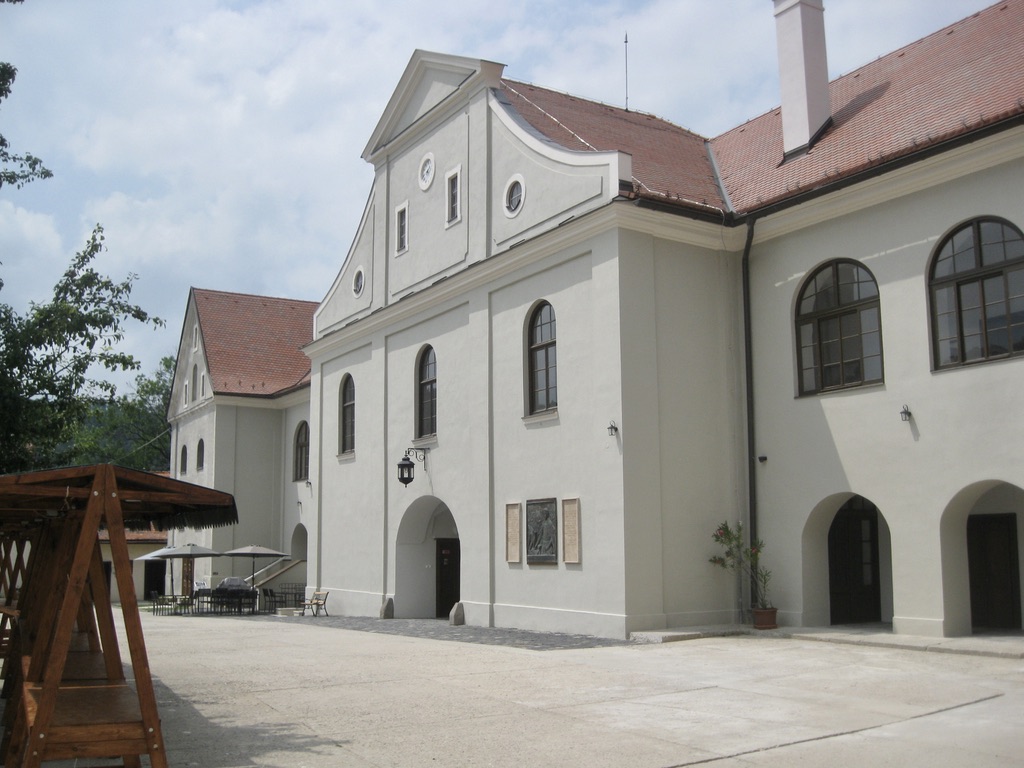







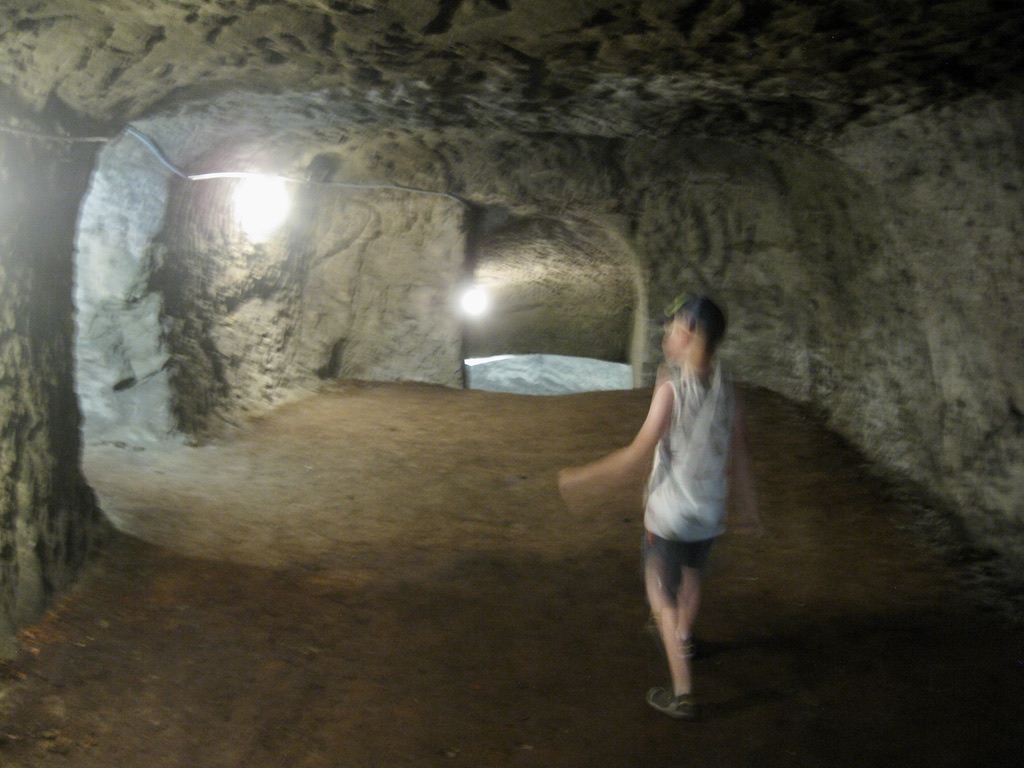

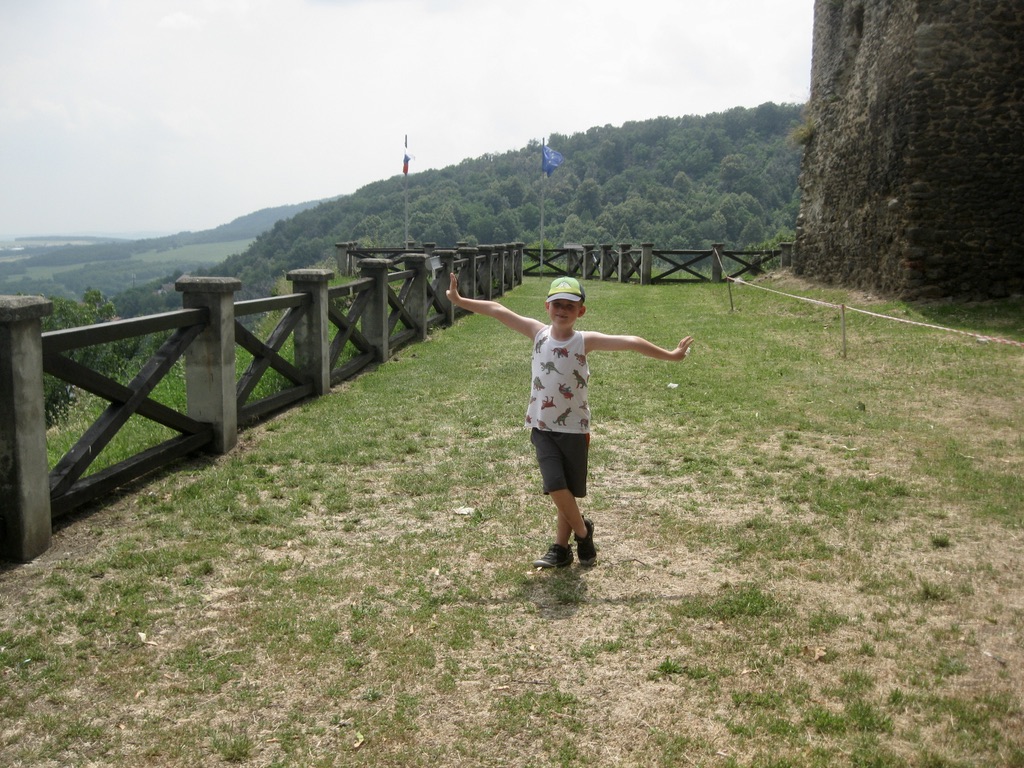
















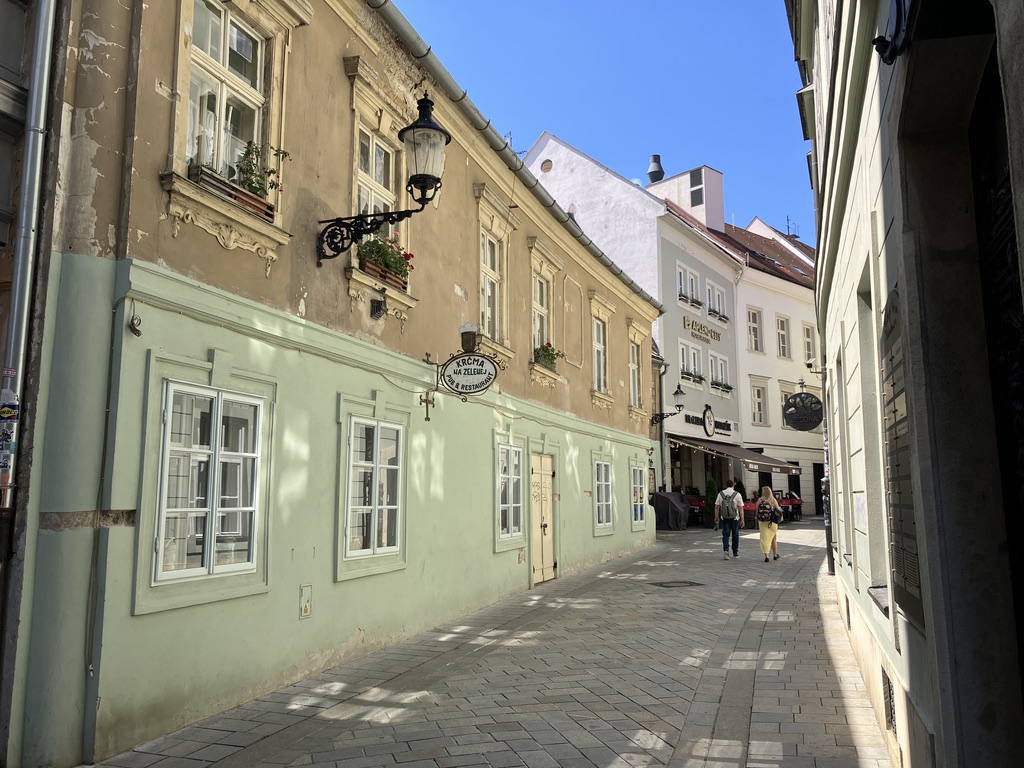





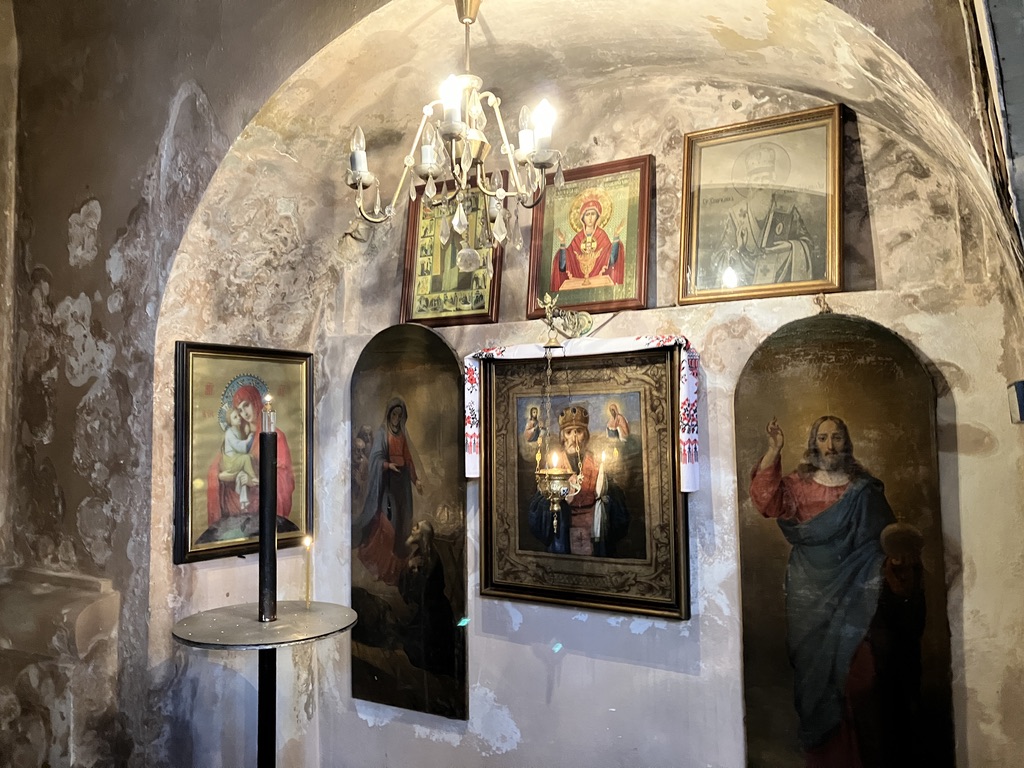



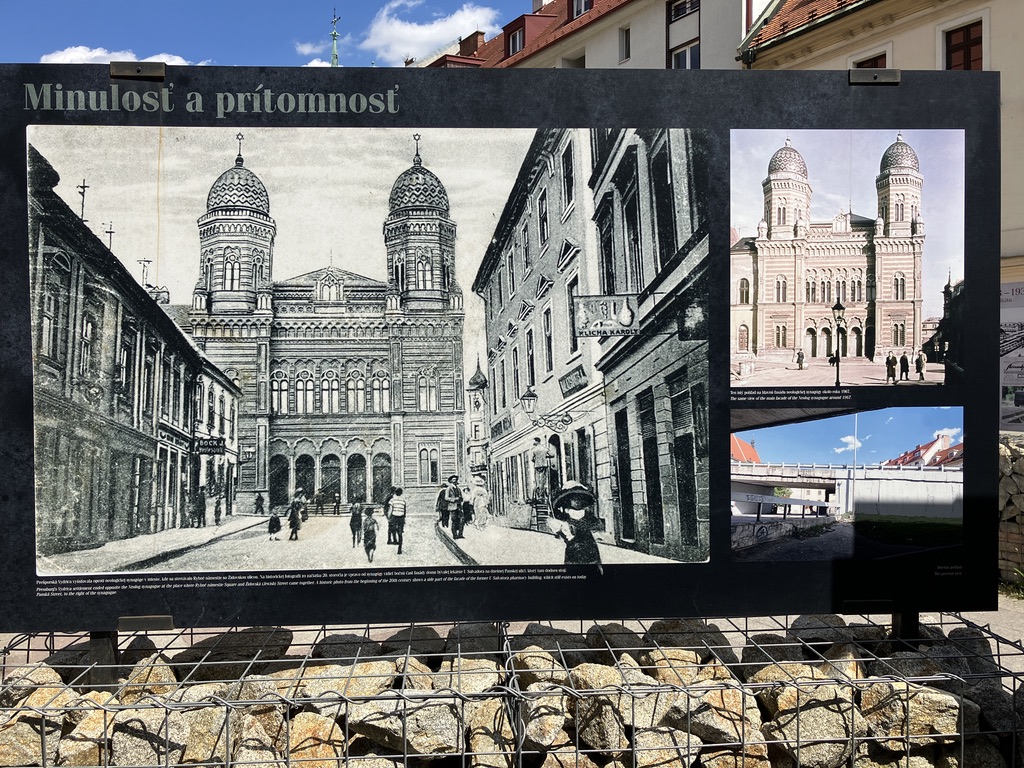













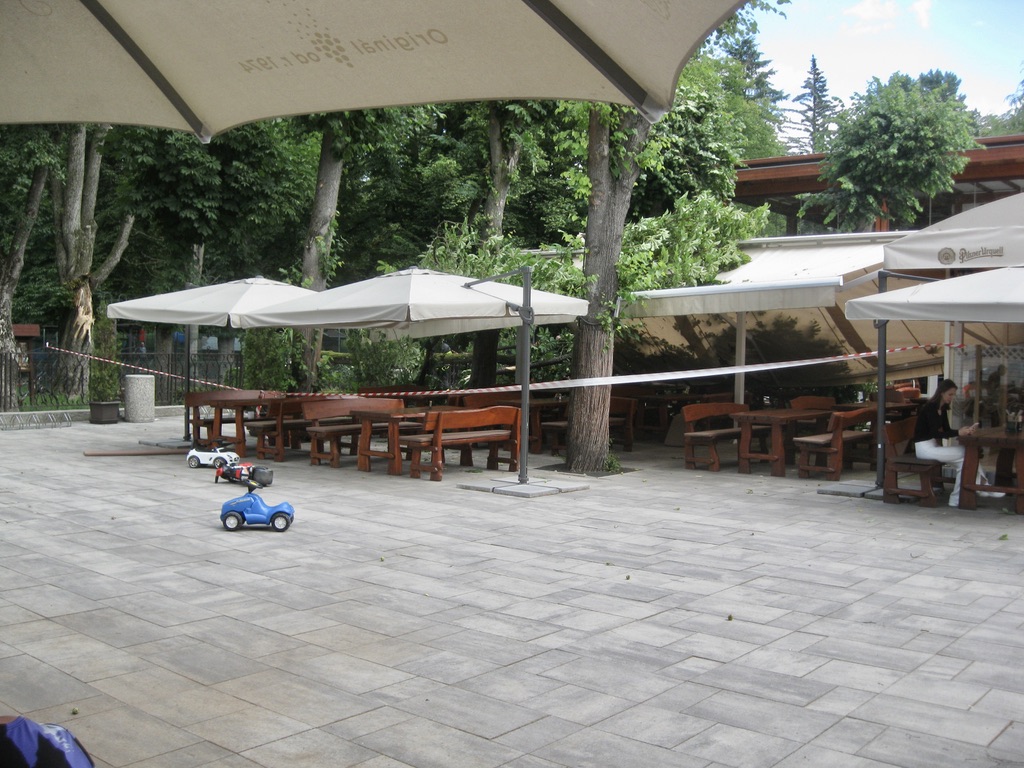

I loved the part about Stink Man and his girlfriend. Great pictures. Now that my kids are old and so busy, I REALLY miss these family vacations.
ReplyDelete